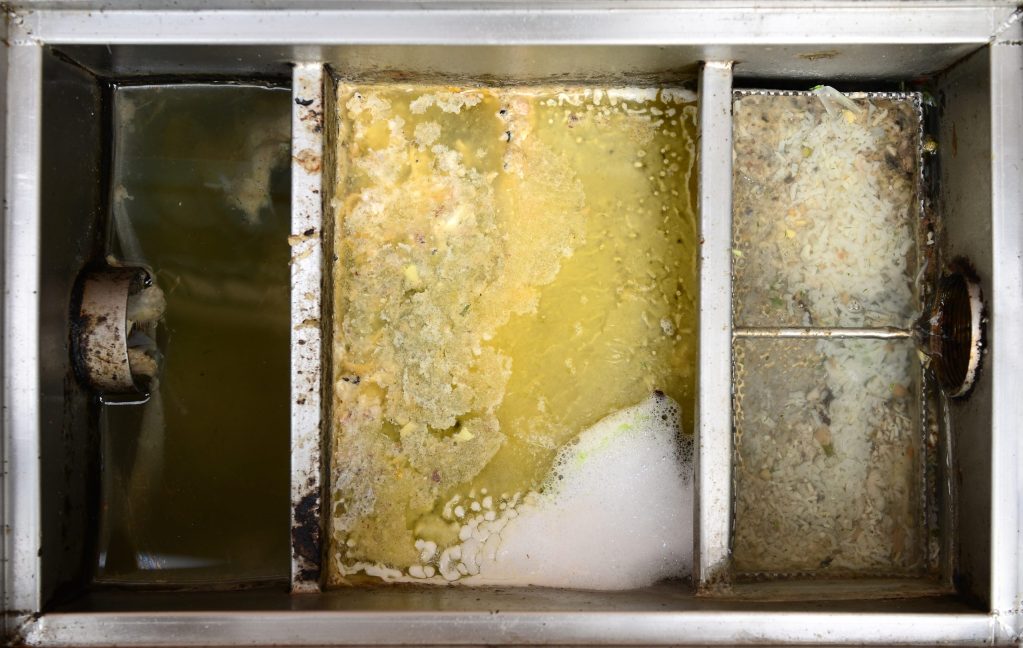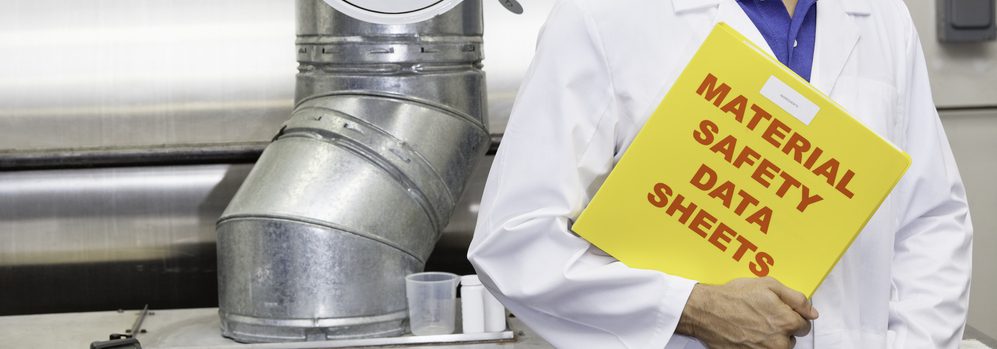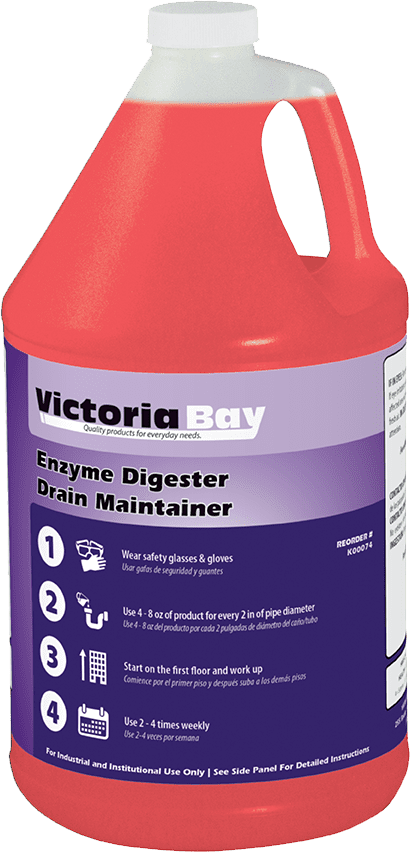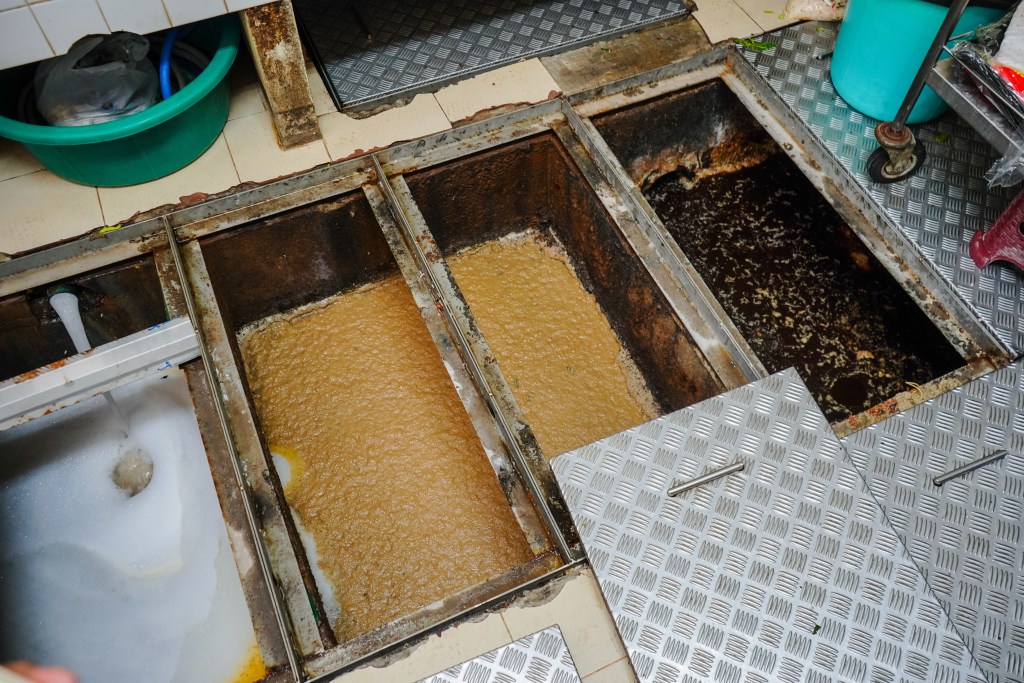There are a million different issues that can cause a commercial kitchen to halt service. You probably wouldn’t expect slow drains to be near the top of the list, but slow drainage can lead to some significant problems.
It doesn’t matter how good the food and service are; when a customer goes to flush the toilet and dirty water spurts out, they’re not coming back. If the food-prep sink is slowly draining, food will come out slower. If the dishwasher is draining slowly, table turnover can be slowed down. Slow service doesn’t leave a good impression on customers.
Above all else, slow draining grease traps can be a huge issue.
Grease traps are designed to prevent 90%-95% of fats, oils, and grease from entering the sewer system, making them vital to wastewater management. When a grease trap isn’t able to perform its job because of slow drainage, it can cause several serious problems, like foul odors, sewer backups, and hefty fines.
If you notice a slow draining grease trap in your commercial kitchen, it needs to be addressed. In this article, we will cover how to fix a slow draining grease trap to avoid running into any significant issues.
Before diving in, let’s quickly review what a grease trap is and how it works.
What is a Grease Trap?
A commercial grease trap, also known as a grease interceptor, is a plumbing device that intercepts and captures fats, oils, and grease, collectively known as FOGs, from wastewater before it reaches the drain.

It’s an important job; otherwise, your commercial kitchen would likely experience a big uptick in clogged drains, blocked sewer pipes, foul odors, and sewer backups. As a result, commercial grease traps are a vital part of any food service establishment’s wastewater management.
How Does a Grease Trap Work?
Commercial grease traps work by slowing wastewater flow so that FOGs can easily be captured.
Picture a tank. Inside the tank, there’s a series of staggered walls, called baffles, on either side. Each baffle works to slow the flow of water through the tank. When the water flows quickly, FOGs are carried directly to the drain. When the water flows slowly, FOGs can rise to the surface, effectively avoiding the drain.
This system enables the grease trap to retain FOGs without preventing wastewater from draining into the sewer. You have to be careful, though. Without proper grease trap maintenance, FOGs can solidify into a large, heavy mass that will eventually block the drain and cause slow drainage.
With all of that out of the way, let’s look at how to fix a slow draining grease trap.
How to Fix a Slow Draining Grease Trap in 4 Steps
The best way to fix a slow draining grease trap is to follow this four-step process using an enzyme-digesting drain maintainer.
- Prepare the Proper PPE
- Gather the Necessary Supplies
- Clean and Pump the Grease Trap
- Treat with an Enzyme-Digesting Drain Maintainer
Let’s take a closer look at each of the steps.
1. Prepare the Proper PPE
The first step is to prepare the proper personal protective equipment (PPE).
Always check the manufacturer’s recommended guidelines regarding PPE. These guidelines can be found on the product label, in the safety data sheet, or on the manufacturer’s website.

We recommend donning goggles and gloves while handling any chemical products. At the very least, they lower the risk of chemical contact with the skin or eyes in the event of a leak or spill.
2. Gather the Necessary Supplies
Once you have the proper PPE, the next step is to ensure you have everything else you’ll need. Fortunately, an enzyme-digesting drain maintainer is all you need to fix a slow draining grease trap.
We recommended using Victoria Bay’s Enzyme Digester Drain Maintainer. It’s designed to attack all organic waste, combat multiple forms of bacteria, and remove malodors at the source.
It’s important to note that, for the best results, this process should be performed during the commercial grease traps’ least active time, which typically means after closing. Why does this matter? Hot water, bleach, and other heavy chemicals inhibit the drain maintainer’s ability to digest enzymes.
3. Clean and Pump the Grease Trap
Now that you’re prepared with the proper PPE and necessary supplies it’s time to clean and pump the grease trap.
This step is vital if you want the enzyme-digesting drain maintainer to perform optimally.
Cleaning and pumping a grease trap is neither quick nor straightforward. It’s too involved to cover in this article, but fortunately for you, we have a detailed guide on How to Clean a Grease Trap in 8 Steps that you can check out on our blog, as well as a video that covers the process on our YouTube:
4. Treat the Grease Trap with Enzyme-Digesting Drain Maintainer

Now that the commercial grease trap has been pumped and cleaned, it’s ready for treatment.
Always check the manufacturer’s recommended guidelines for use with your product before starting the treatment.
The Victoria Bay Enzyme-Digesting Drain Maintainer has different recommendations depending on the size of the grease trap.
For grease traps 20 cubic feet or less, pour 32 oz. of product into the opening closest to the trap. For larger traps, use 32 oz. per 20 cubic feet.
It’s as simple as that. Once you pour the product in, just let it sit for as long as possible before using the grease trap again. This is why, earlier, we recommended performing the treatment after regular business hours. Doing so ensures the best results.
Final Thoughts
Commercial grease traps are a vital component of an efficient foodservice operation. When an issue arises with grease trap drainage, it can lead to many unpleasant consequences, like foul odors, sewer backups, and even regulatory fines.
That’s why it’s best to address a slow draining grease trap as soon as possible. We put together this guide to make fixing a slow draining grease trap as easy as possible for you.
However, using an auto timer to dispense the enzyme-digesting drain maintainer can make the process even easier. Not only is it easier, but, because the timing is inconvenient and the product is less effective when used while hot water and chemicals are present, it’s actually highly recommended.
An auto timer can be installed directly in the grease trap, eliminating the need to manually add product and the hassle of waiting until after business hours to perform the process.
All the while, you’re guaranteed consistent and effective grease trap maintenance.
Even when you do have to pump it out, it will be a quick and efficient process thanks to the drain maintainer. That means you rely on a professional to pump and clean your commercial grease traps. You can save on cleanings, pumpings, and the cost of hiring a professional with as much as four gallons of drain maintainer dispersed through an auto timer.
For more information about setting up an auto timer, reach out to an Imperial Dade facility near you. One of our foodservice experts will come to your facility and see how much time and money an auto timer can save your business.
You may even be eligible for free auto timer installation with the purchase of an enzyme-digesting drain maintainer!
To learn more about how using an enzyme digesting drain maintainer can help solve your drainage problems, or to set up a demo with the auto timer, get in touch with the experts at Imperial Dade.
Check Out These Related Articles and Videos:
- 5 Most Common Mistakes in Your Warewashing Program & How to Fix Them
- What is Drain Maintainer & When Should it be Used?
- Safety Checklist: 6 Points of Personal Protective Equipment
- MSDS vs SDS Explained: Where to Find, How to Read, & What to Look For
- How Can Food Handlers Reduce Bacteria in Food Processing Plants?
- How to Clean a Grease Trap in 8 Steps
